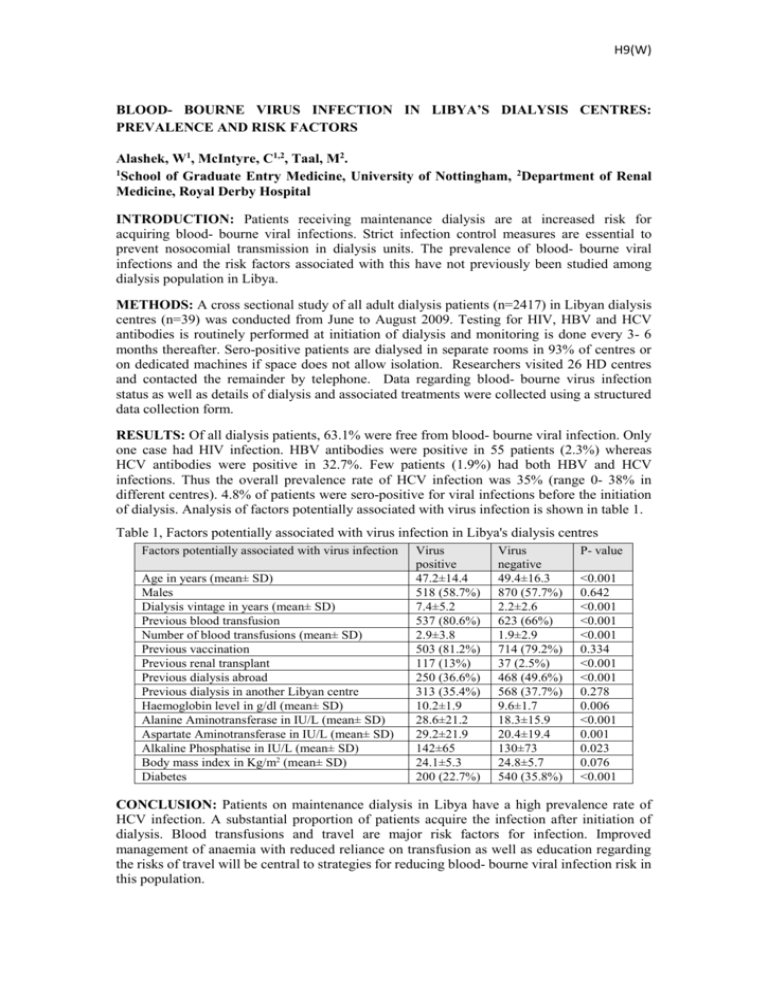Hepatitis C Virus in Libya`s Haemodialysis Centres: Prevalence
advertisement

H9(W) BLOOD- BOURNE VIRUS INFECTION IN LIBYA’S DIALYSIS CENTRES: PREVALENCE AND RISK FACTORS Alashek, W1, McIntyre, C1,2, Taal, M2. 1 School of Graduate Entry Medicine, University of Nottingham, 2Department of Renal Medicine, Royal Derby Hospital INTRODUCTION: Patients receiving maintenance dialysis are at increased risk for acquiring blood- bourne viral infections. Strict infection control measures are essential to prevent nosocomial transmission in dialysis units. The prevalence of blood- bourne viral infections and the risk factors associated with this have not previously been studied among dialysis population in Libya. METHODS: A cross sectional study of all adult dialysis patients (n=2417) in Libyan dialysis centres (n=39) was conducted from June to August 2009. Testing for HIV, HBV and HCV antibodies is routinely performed at initiation of dialysis and monitoring is done every 3- 6 months thereafter. Sero-positive patients are dialysed in separate rooms in 93% of centres or on dedicated machines if space does not allow isolation. Researchers visited 26 HD centres and contacted the remainder by telephone. Data regarding blood- bourne virus infection status as well as details of dialysis and associated treatments were collected using a structured data collection form. RESULTS: Of all dialysis patients, 63.1% were free from blood- bourne viral infection. Only one case had HIV infection. HBV antibodies were positive in 55 patients (2.3%) whereas HCV antibodies were positive in 32.7%. Few patients (1.9%) had both HBV and HCV infections. Thus the overall prevalence rate of HCV infection was 35% (range 0- 38% in different centres). 4.8% of patients were sero-positive for viral infections before the initiation of dialysis. Analysis of factors potentially associated with virus infection is shown in table 1. Table 1, Factors potentially associated with virus infection in Libya's dialysis centres Factors potentially associated with virus infection Age in years (mean± SD) Males Dialysis vintage in years (mean± SD) Previous blood transfusion Number of blood transfusions (mean± SD) Previous vaccination Previous renal transplant Previous dialysis abroad Previous dialysis in another Libyan centre Haemoglobin level in g/dl (mean± SD) Alanine Aminotransferase in IU/L (mean± SD) Aspartate Aminotransferase in IU/L (mean± SD) Alkaline Phosphatise in IU/L (mean± SD) Body mass index in Kg/m2 (mean± SD) Diabetes Virus positive 47.2±14.4 518 (58.7%) 7.4±5.2 537 (80.6%) 2.9±3.8 503 (81.2%) 117 (13%) 250 (36.6%) 313 (35.4%) 10.2±1.9 28.6±21.2 29.2±21.9 142±65 24.1±5.3 200 (22.7%) Virus negative 49.4±16.3 870 (57.7%) 2.2±2.6 623 (66%) 1.9±2.9 714 (79.2%) 37 (2.5%) 468 (49.6%) 568 (37.7%) 9.6±1.7 18.3±15.9 20.4±19.4 130±73 24.8±5.7 540 (35.8%) P- value ˂0.001 0.642 ˂0.001 ˂0.001 ˂0.001 0.334 ˂0.001 ˂0.001 0.278 0.006 ˂0.001 0.001 0.023 0.076 ˂0.001 CONCLUSION: Patients on maintenance dialysis in Libya have a high prevalence rate of HCV infection. A substantial proportion of patients acquire the infection after initiation of dialysis. Blood transfusions and travel are major risk factors for infection. Improved management of anaemia with reduced reliance on transfusion as well as education regarding the risks of travel will be central to strategies for reducing blood- bourne viral infection risk in this population.





